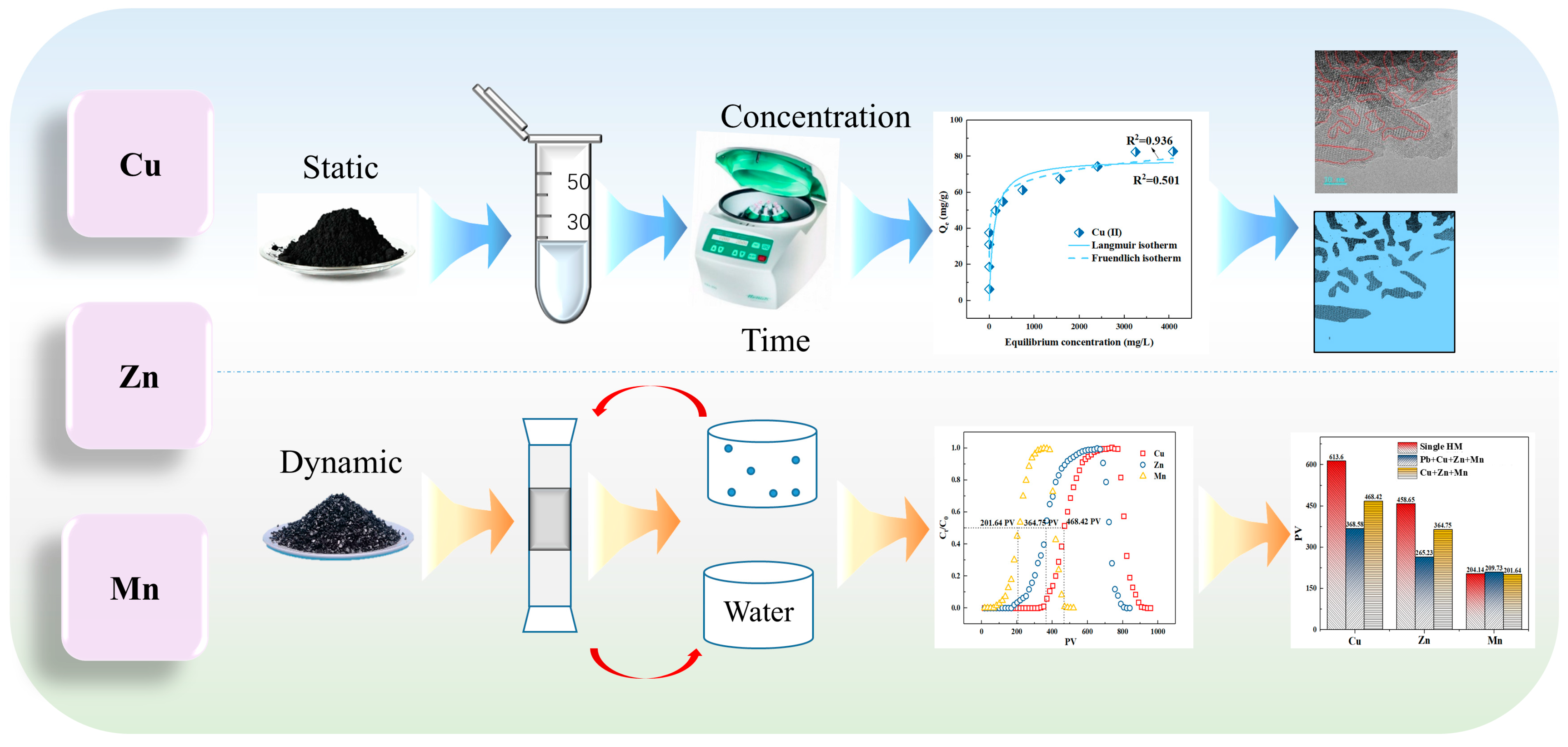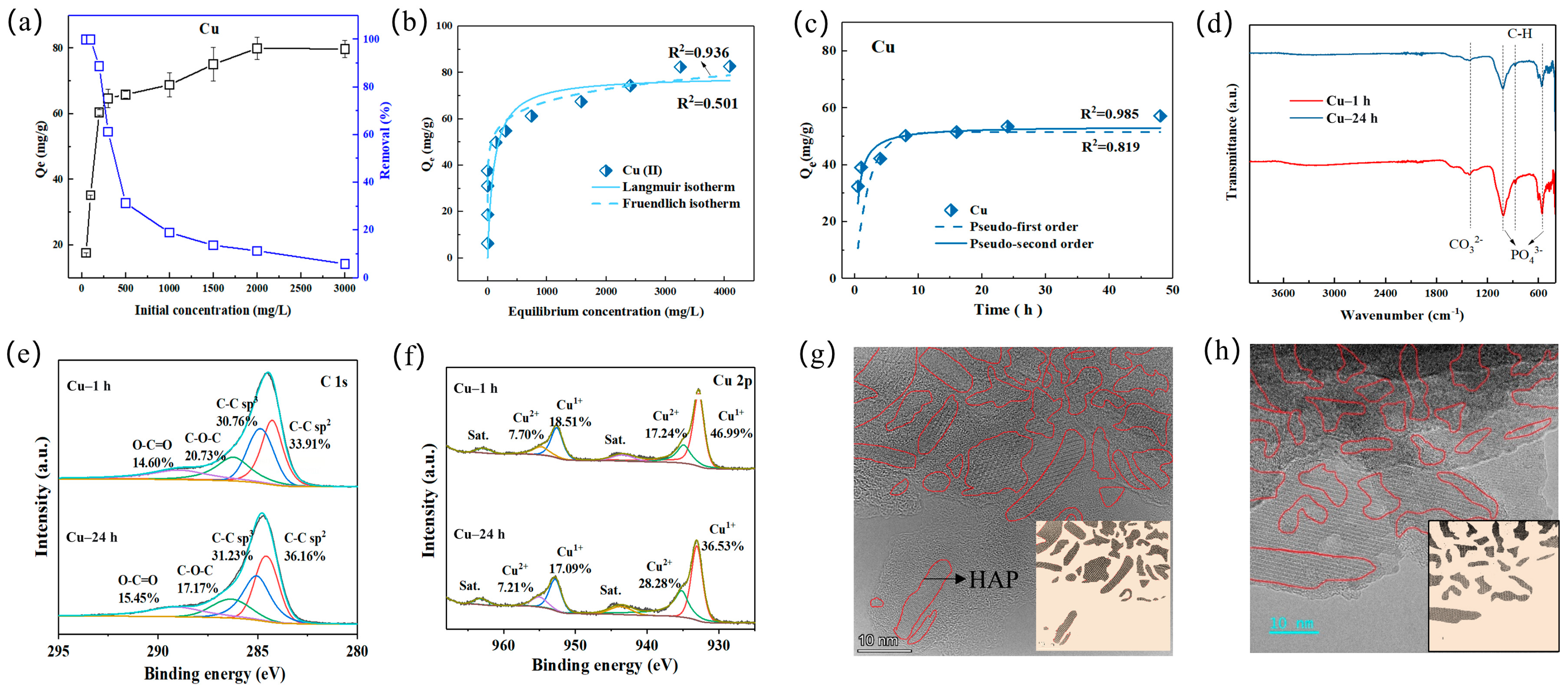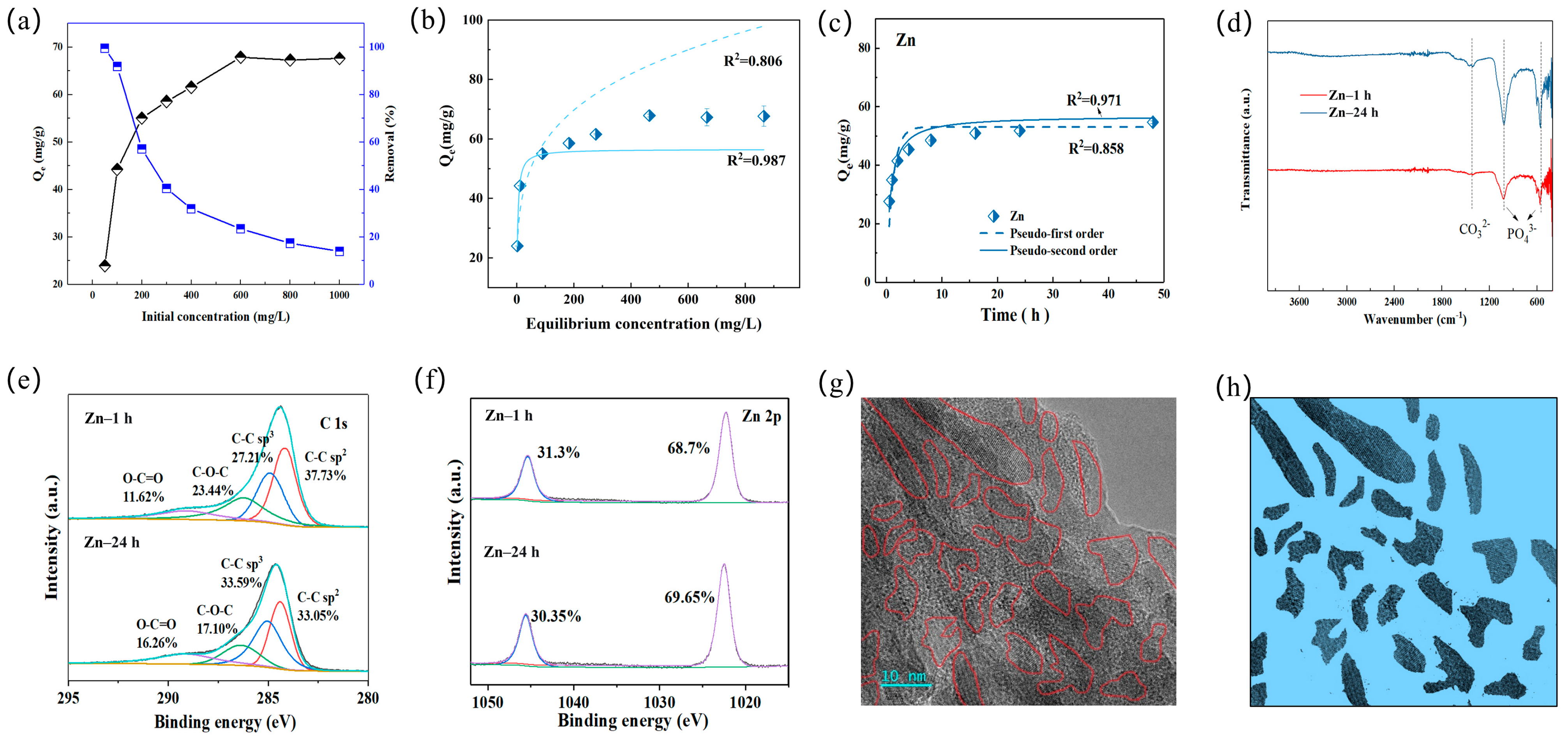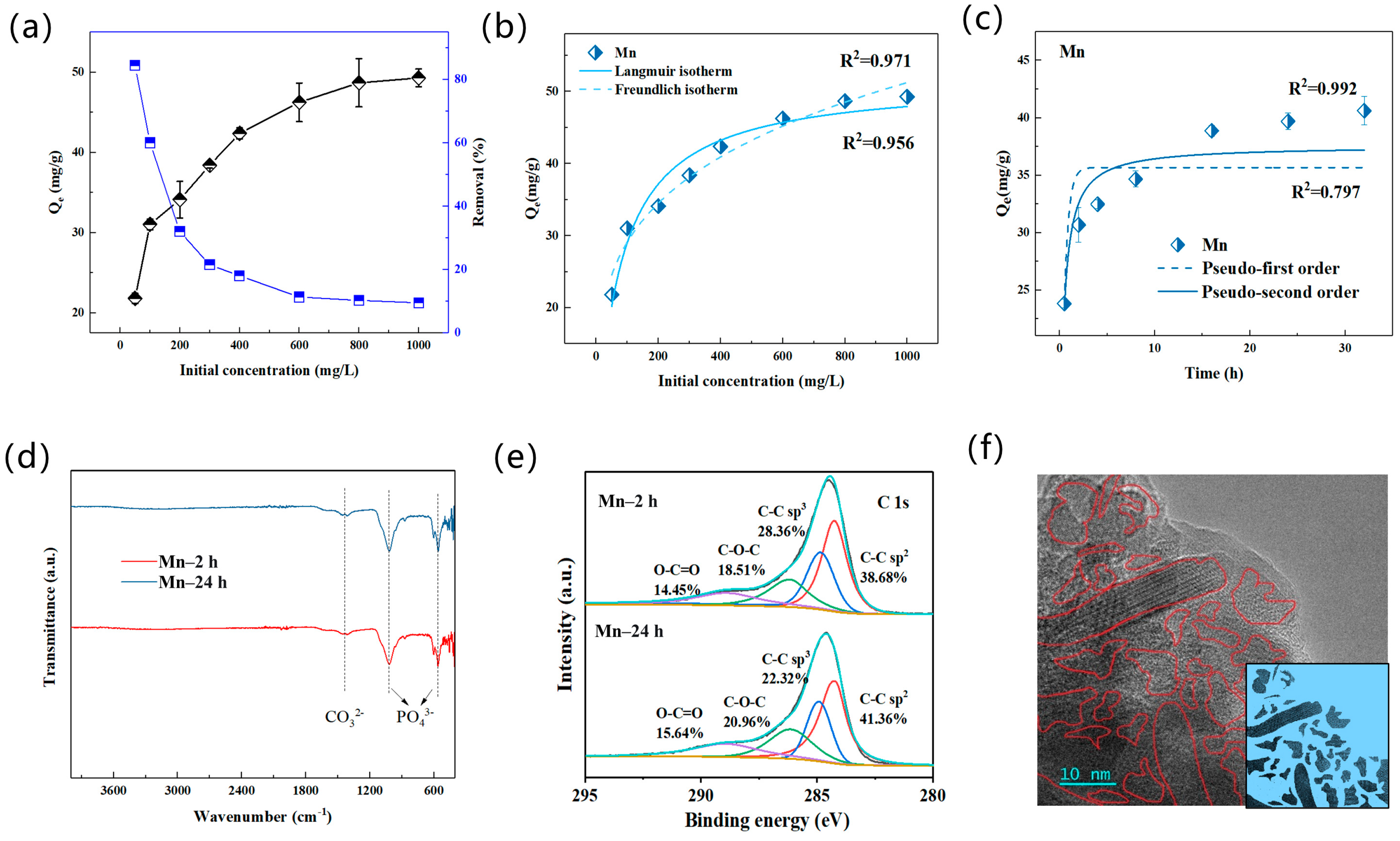Evaluating Carbon/Hydroxyapatite’s Efficacy in Removing Heavy Metals from Groundwater
Abstract
1. Introduction
2. Materials and Methods
2.1. Preparation of Experimental Materials
2.2. Characterization and Analysis Methods
2.3. Experimental Method for Removal of Heavy Metals
2.3.1. Static Adsorption Experiment
2.3.2. Dynamic Penetration Experiment
3. Results and Discussion
3.1. Static Adsorption Experiment Results of Copper
3.2. Static Adsorption Experiment Results of Zinc
3.3. Static Adsorption Experiment Results of Manganese
3.4. Static Mixed Adsorption Experiment Results
3.5. Dynamic Penetration Test Results
4. Conclusions
Supplementary Materials
Author Contributions
Funding
Data Availability Statement
Conflicts of Interest
References
- Yu, G.; Chen, F.; Zhang, H.; Wang, Z. Pollution and health risk assessment of heavy metals in soils of Guizhou, China. Ecosyst. Health Sustain. 2021, 7, 1859948. [Google Scholar] [CrossRef]
- Sheremeti-Kabashi, F.; Kutllovci, F.; Mangjolli, B.; Hasani, A. Investigation of heavy metal concentrations in the Kelmend tailings landfill and ecological assessment of pollution. Min. Miner. Depos. 2024, 18, 110–118. [Google Scholar] [CrossRef]
- Vesković, J.; Onjia, A. Environmental Implications of the Soil-to-Groundwater Migration of Heavy Metals in Mining Area Hotspots. Metals 2024, 14, 719. [Google Scholar] [CrossRef]
- Xiao, R.; Guo, D.; Ali, A.; Mi, S.; Liu, T.; Ren, C.; Li, R.; Zhang, Z. Accumulation, ecological-health risks assessment, and source apportionment of heavy metals in paddy soils: A case study in Hanzhong, Shaanxi, China. Environ. Pollut. 2019, 248, 349–357. [Google Scholar] [CrossRef]
- Xue, Y.; Teng, W.; Chen, Y.; Ma, Q.; Chen, X.; Sun, Y.; Fan, J.; Qiu, Y.; Fu, R. Amorphous Mn-La oxides immobilized on carbon sphere for efficient removal of As(Ⅴ), Cd(II), and Pb(II): Co-adsorption and roles of Mn species. Chem. Eng. J. 2022, 429, 132262. [Google Scholar] [CrossRef]
- Xiao, J.; Hu, R.; Chen, G. Micro-nano-engineered nitrogenous bone biochar developed with a ball-milling technique for high-efficiency removal of aquatic Cd(II), Cu(II) and Pb(II). J. Hazard. Mater. 2020, 387, 121980. [Google Scholar] [CrossRef]
- Betts, A.R.; Chen, N.; Hamilton, J.G.; Peak, D. Rates and mechanisms of Zn2+ adsorption on a meat and bonemeal biochar. Environ. Sci. Technol. 2013, 47, 14350–14357. [Google Scholar] [CrossRef]
- Rysbekov, K.; Yinli, B.; Demeuov, S.; Mukanova, G.; Zhakypbek, Y. Assessment of soil polution by нeavy metals in the area of open mining works. Vestn. KazNRTU 2021, 143, 14–25. [Google Scholar] [CrossRef]
- Aluwong, K.C.; Hashim, M.H.M.; Ismail, S.; Shehu, S.A. Physico-chemical assessment of surface water from mining activities in Maiganga coal mine, Gombe state, Nigeria. Min. Miner. Depos. 2024, 18, 9–17. [Google Scholar] [CrossRef]
- Jia, T.; Guo, T.; Yao, Y.; Wang, R.; Chai, B. Seasonal Microbial Community Characteristic and Its Driving Factors in a Copper Tailings Dam in the Chinese Loess Plateau. Front. Microbiol. 2020, 11, 1574. [Google Scholar] [CrossRef]
- Hao, R.; Li, D.; Zhang, J.; Jiao, T. Green Synthesis of Iron Nanoparticles Using Green Tea and Its Removal of Hexavalent Chromium. Nanomaterials 2021, 11, 650. [Google Scholar] [CrossRef]
- Abdykadyrov, A.; Abdullayev, S.; Tashtay, Y.; Zhunussov, K.; Marxuly, S. Purification of surface water by using the corona discharge method. Min. Miner. Depos. 2024, 18, 125–137. [Google Scholar] [CrossRef]
- Kuang, X.; Wang, W.; Hu, J.; Liu, W.; Zeng, W. Subcellular distribution and chemical forms of manganese in Daucus carota in relation to its tolerance. Front. Plant Sci. 2022, 13, 947882. [Google Scholar] [CrossRef]
- Long, J.; Tan, D.; Deng, S.; Lei, M. Pollution and ecological risk assessment of antimony and other heavy metals in soils from the world's largest antimony mine area, China. Hum. Ecol. Risk Assess. Int. J. 2017, 24, 679–690. [Google Scholar] [CrossRef]
- Li, H.; Liu, Q. Reaction medium for permeable reactive barrier remediation of groundwater polluted by heavy metals. Front. Environ. Sci. 2022, 10, 968546. [Google Scholar] [CrossRef]
- Chen, X.; Li, F.; Zhang, J.; Liu, S.; Ou, C.; Yan, J.; Sun, T. Status, fuzzy integrated risk assessment, and hierarchical risk management of soil heavy metals across China: A systematic review. Sci. Total Environ. 2021, 785, 147180. [Google Scholar] [CrossRef] [PubMed]
- Mohd Pu’ad, N.A.S.; Abdul Haq, R.H.; Mohd Noh, H.; Abdullah, H.Z.; Idris, M.I.; Lee, T.C. Synthesis method of hydroxyapatite: A review. Mater. Today Proc. 2020, 29, 233–239. [Google Scholar] [CrossRef]
- Song, Y.; Zhang, M.; Li, H.; Yang, Y.; Chen, X.; Li, J.; Brogi, A. Effect of Chromium Ion on the Strength Characteristics and Damage Law of Red Clay. Geofluids 2022, 2022, 8451476. [Google Scholar] [CrossRef]
- Kong, L.; Liu, X.; Lv, G.; Liu, T.; Zhang, P.; Li, Y.; Chen, B.; Liao, L.; Zhang, T. Copper Adsorption Using Hydroxyapatite Derived from Bovine Bone. Adv. Civ. Eng. 2022, 2022, 1026129. [Google Scholar] [CrossRef]
- Fuller, C.C.; Bargar, J.R.; Davis, J.A. Molecular-Scale Characterization ofUranium Sorption by Bone ApatiteMaterials for a Permeable ReactiveBarrier Demonstration. Environ. Sci. Technol. 2003, 37, 4642–4649. [Google Scholar]
- Adhikari, T.; Dharmarajan, R.; Lamb, D.; Zhang, H. Remediation of Frogmore Mine Spoiled Soil with Nano Enhanced Materials. Soil Sediment Contam. Int. J. 2021, 31, 367–385. [Google Scholar] [CrossRef]
- Chen, M.; Zhang, Z.; Hu, X.; Tian, J.; Wang, J.; Wan, R.; Cui, X.; Zhou, X.; Liu, D. Adsorption of Si(OH)4 and Al(OH)4 onto arsenopyrite surface: Exploring the sealing feasibility of geopolymer to arsenopyrite. Miner. Eng. 2021, 170, 107017. [Google Scholar] [CrossRef]
- Huang, X.; Zhu, F.; He, Z.; Chen, X.; Wang, G.; Liu, M.; Xu, H. Photosynthesis Performance and Antioxidative Enzymes Response of Melia azedarach and Ligustrum lucidum Plants Under Pb–Zn Mine Tailing Conditions. Front. Plant Sci. 2020, 11, 571157. [Google Scholar] [CrossRef]
- Wang, P.; Sun, Z.; Hu, Y.; Cheng, H. Leaching of heavy metals from abandoned mine tailings brought by precipitation and the associated environmental impact. Sci. Total Environ. 2019, 695, 133893. [Google Scholar] [CrossRef]
- Yu, Q.; Liu, H.; Lv, G.; Liu, X.; Wang, L.; Liao, L. Mechanistic insight into lead immobilization on bone-derived carbon/hydroxyapatite composite at low and high initial lead concentration. Sci. Total Environ. 2023, 900, 165910. [Google Scholar] [CrossRef]
- Joshi, P.; Manocha, S. Kinetic and thermodynamic studies of the adsorption of copper ions on hydroxyapatite nanoparticles. Mater. Today Proc. 2017, 4, 10455–10459. [Google Scholar] [CrossRef]
- Sellaoui, L.; Mendoza-Castillo, D.I.; Reynel-Ávila, H.E.; Bonilla-Petriciolet, A.; Ben Lamine, A.; Erto, A. A new statistical physics model for the ternary adsorption of Cu2+, Cd2+ and Zn2+ ions on bone char: Experimental investigation and simulations. Chem. Eng. J. 2018, 343, 544–553. [Google Scholar] [CrossRef]
- Ben-Ali, S.; Jaouali, I.; Souissi-Najar, S.; Ouederni, A. Characterization and adsorption capacity of raw pomegranate peel biosorbent for copper removal. J. Clean. Prod. 2017, 142, 3809–3821. [Google Scholar] [CrossRef]
- Kali, A.; Amar, A.; Loulidi, I.; Jabri, M.; Hadey, C.; Lgaz, H.; Alrashdi, A.A.; Boukhlifi, F. Characterization and adsorption capacity of four low-cost adsorbents based on coconut, almond, walnut, and peanut shells for copper removal. Biomass Convers. Biorefinery 2022, 14, 3655–3666. [Google Scholar] [CrossRef]
- Xue, Y.; Yu, Q.; Fang, J.; Jia, Y.; Wang, R.; Fan, J. A Wetting and Capture Strategy Overcoming Electrostatic Repulsion for Electroreduction of Nitrate to Ammonia from Low-Concentration Sewage. Small 2024, 20, 2400505. [Google Scholar] [CrossRef]
- Xue, Y.; Yu, Q.; Ma, Q.; Chen, Y.; Zhang, C.; Teng, W.; Fan, J.; Zhang, W.-x. Electrocatalytic Hydrogenation Boosts Reduction of Nitrate to Ammonia over Single-Atom Cu with Cu(I)-N3C1 Sites. Environ. Sci. Technol. 2022, 56, 14797–14807. [Google Scholar] [CrossRef]
- Kızıltas Demir, S.; Tugrul, N. Zinc and cadmium adsorption from wastewater using hydroxyapatite synthesized from flue gas desulfurization waste. Water Sci. Technol. 2021, 84, 1280–1292. [Google Scholar] [CrossRef]
- Zhu, Z.; Wu, Y.; Hu, C.; Zhang, L.; Ding, H.; Zhu, Y.; Fan, Y.; Deng, H.; Zhou, X.; Tang, S. Elimination of zinc ions from aqueous solution by a hydroxylapatite-biochar composite material with the hierarchical porous microstructures of sugarcane waste. J. Clean. Prod. 2022, 362, 132483. [Google Scholar] [CrossRef]
- Rudi, N.N.; Muhamad, M.S.; Te Chuan, L.; Alipal, J.; Omar, S.; Hamidon, N.; Abdul Hamid, N.H.; Mohamed Sunar, N.; Ali, R.; Harun, H. Evolution of adsorption process for manganese removal in water via agricultural waste adsorbents. Heliyon 2020, 6, e05049. [Google Scholar] [CrossRef]






Disclaimer/Publisher’s Note: The statements, opinions and data contained in all publications are solely those of the individual author(s) and contributor(s) and not of MDPI and/or the editor(s). MDPI and/or the editor(s) disclaim responsibility for any injury to people or property resulting from any ideas, methods, instructions or products referred to in the content. |
© 2025 by the authors. Licensee MDPI, Basel, Switzerland. This article is an open access article distributed under the terms and conditions of the Creative Commons Attribution (CC BY) license (https://creativecommons.org/licenses/by/4.0/).
Share and Cite
Yu, Q.; Liu, H.; Lv, G.; Liu, X.; Wang, L.; Mei, L.; Liao, L. Evaluating Carbon/Hydroxyapatite’s Efficacy in Removing Heavy Metals from Groundwater. Water 2025, 17, 914. https://doi.org/10.3390/w17070914
Yu Q, Liu H, Lv G, Liu X, Wang L, Mei L, Liao L. Evaluating Carbon/Hydroxyapatite’s Efficacy in Removing Heavy Metals from Groundwater. Water. 2025; 17(7):914. https://doi.org/10.3390/w17070914
Chicago/Turabian StyleYu, Qihui, Hao Liu, Guocheng Lv, Xin Liu, Lijuan Wang, Lefu Mei, and Libing Liao. 2025. "Evaluating Carbon/Hydroxyapatite’s Efficacy in Removing Heavy Metals from Groundwater" Water 17, no. 7: 914. https://doi.org/10.3390/w17070914
APA StyleYu, Q., Liu, H., Lv, G., Liu, X., Wang, L., Mei, L., & Liao, L. (2025). Evaluating Carbon/Hydroxyapatite’s Efficacy in Removing Heavy Metals from Groundwater. Water, 17(7), 914. https://doi.org/10.3390/w17070914





